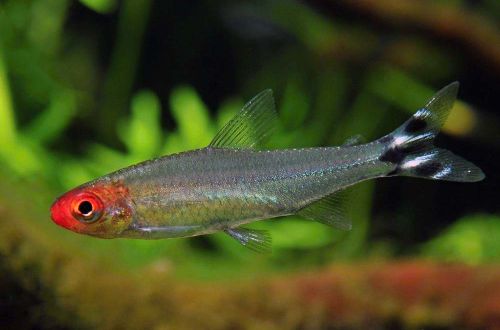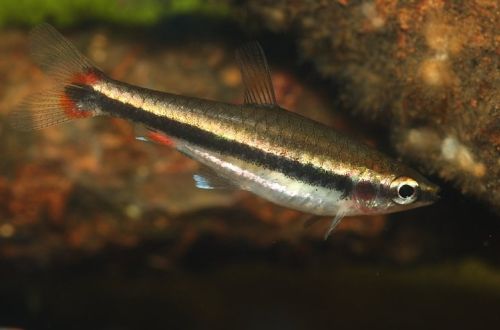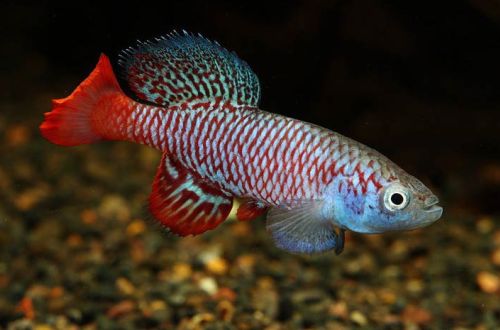
Rhodostomus
Rhodostomus, scientific name Hemigrammus rhodostomus, belongs to the Characidae family. A popular and relatively unpretentious fish, it gets along well with many other well-known species, it is easy to keep and breed.

Contents
Habitat
It comes from the Orinoco River basin and the upper Amazon, which is on the territory of modern Venezuela and Brazil. It lives in numerous tributaries of larger rivers, which have a characteristic light brown color of water due to the high concentration of tannins – decay products of organic matter (leaves, branches, tree roots, herbaceous plants, etc.).
Brief information:
- The volume of the aquarium – from 70 liters.
- Temperature – 24-28°C
- Value pH — 5.0–7.0
- Water hardness – soft (1-12 dGH)
- Substrate type – any sandy
- Lighting – subdued
- Brackish water – no
- Water movement is weak
- The size of the fish is up to 5 cm.
- Food – any food
- Temperament – peaceful
- Keeping in a flock of at least 6-10 individuals
Description
Adults reach about 5 cm in length. The body color is silvery or translucent, the tail has black and white markings. The head is painted red. It is worth noting that the Red-nosed Tetra, the closest relative of Rhodostomus, looks similar, it is quite difficult to distinguish them even for an experienced aquarist. Professionals note that in Rhodostomus the coloration of the head ends on the gill covers, while in the Red-nosed Tetra it continues further on the body.
The identification confusion is exacerbated by the presence on the aquarium fish market of another species with identical coloration – the False Red-nosed Tetra. The latter can be distinguished by an elongated black stroke on the caudal peduncle.
Food
At home, it accepts all types of food for aquarium fish of a suitable size. A balanced diet is based on a combination of various foods, such as dry flakes and pellets with live or frozen bloodworms, daphnia. If you do not want to mess around with various larvae and crustaceans, you can purchase specialized food from well-known manufacturers, which already includes freeze-dried protein supplements.
Maintenance and care, arrangement of the aquarium
The minimum tank size for a small flock of Rhodostomus starts at 70 liters. The design uses coarse river sand, several snags and dense thickets of plants (preferably shade-loving species) located in groups. The lighting is subdued, for the purpose of additional shading, floating plants can be added. Tree leaves and a filter with peat-based filter material are used to simulate the characteristic brownish color of the water. Before placing the leaves in the aquarium, they are first dried and then soaked until they sink. Leaves are renewed every few weeks. Another equally effective way is to use a rag bag filled with natural peat, which has been specially treated beforehand to become safe for the aquarium ecosystem. It is purchased exclusively in pet stores and in no case is collected in natural reservoirs / swamps.
Water conditions have slightly acidic pH values with low to medium hardness (dGH). The acceptable temperature range is 24-28°C. The level of pollution with organic waste (uneaten pieces of food, excrement) is minimal. Long-term presence of fish in unsuitable conditions will negatively affect their well-being, the first sign will be a faded color. Regularly check all water parameters and update it weekly by 15–20% of the volume.
Behavior and Compatibility
A peaceful flocking species, very mobile, and therefore will cause inconvenience to slower neighbors. Pairs well with fish of similar size and temperament such as the Red Nosed Tetra, Pulcher, Peruvian Tetra, Discus and many other South Americans. The content in the flock is at least 6 individuals, with a smaller number they become shy, less active, lose their color.
Breeding / breeding
Refers to spawning species, parental instincts are weakly expressed, so eggs and fry can be eaten by adult fish. Breeding should be organized in a separate tank – a spawning aquarium. Usually they use a tank with a volume of about 20 liters, the design does not matter. In order to protect future offspring, the bottom is covered with a fine mesh or a layer of balls 1–2 cm in diameter, or dense thickets of low small-leaved plants or mosses are planted. Fill with water from the main aquarium just before placing the fish. Of the equipment, a simple sponge airlift filter and a heater are sufficient. There is no need for a lighting system, Rhodostomus prefers dim light during the spawning period.
Spawning is stimulated by the establishment of pH and dGH values at 5.5–6.5 and 1–5, respectively, at a temperature of about 26–28°C. In the diet, a significant proportion should be protein products (bloodworm, daphnia, brine shrimp, etc.). After some time, some fish will become significantly rounded – it is the females who will fill with caviar.
Females and the largest and brightest males are placed in a separate aquarium. At the end of spawning, the newly-minted parents are returned back. The fry appear after 24–36 hours, and already on the 3rd–4th day they begin to swim freely, from this moment they need food. Feed with special food for juvenile aquarium fish.
Fish diseases
A balanced aquarium biosystem with suitable conditions is the best guarantee against the occurrence of any diseases, therefore, if the fish has changed behavior, color, unusual spots and other symptoms appear, first check the water parameters, and only then proceed to treatment.





